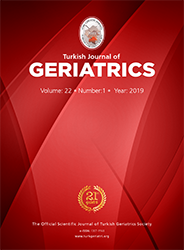2Cumhuriyet University, Faculty of Medicine, Department of Chest Disease, Sivas, Turkey DOI : 10.31086/tjgeri.2019150574 Introduction: Skeletal muscle weakness is a major systemic manifestation of chronic obstructive pulmonary disease (COPD). Loss of muscle mass contributes to impaired exercise capacity and peripheral muscle weakness and manifests as reduced fat-free mass in patients with COPD. This study aimed to examine the effects of fat-free mass, body mass index and airway obstruction severity on exercise capacity.
Materials and Method: This study included 70 patients with COPD and 70 healthy individuals. Patients with COPD were divided into two groups: non-severe (GOLD Stage 1,2) and severe (GOLD Stage 2,3). Body mass index, fat-free mass, fat mass and percentage fat mass were measured, and pulmonary function tests were performed for all participants. The six-minute walk test was used as an index of exercise capacity. The Student"s t-test, chi-square test and Pearson"s correlation coefficient were used to compare study parameters.
Results: The average fat mass, percentage fat mass and six-minute walk test were reduced in the COPD cohort. No significant correlations were found between the six-minute walk test and body mass index, fat-free mass, fat mass and percentage fat mass. A significant correlation was found between the six-minute walk test and forced expiratory volume in one second (FEV1), forced vital capacity (FVC) and FEV1/FVC in patients with non-severe COPD.
Conclusion: Exercise capacity is significantly reduced in patients with COPD. The significant relationship between the six-minute walk test score and pulmonary function test variables indicates that disease-related obstruction affects exercise capacity.
Keywords : Exercise; Body mass index; Pulmonary Disease, Chronic Obstructive
